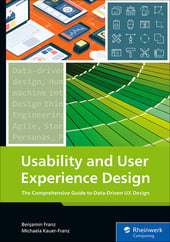Curious how to get user feedback faster than ever? Discover the ins and outs of rapid user testing—an efficient, cost-effective way to refine your web applications in record time.
A rapid user test is a slimmed-down version of a usability and UX test carried out remotely via a platform. A test can be prepared in advance via a digital platform and then presented to the users automatically or, if desired, by a moderator. Due to the high degree of automation, the test results can be available within a day.
Rapid user testing is becoming increasingly important in practice due to the speed with which tests can be performed. At the current time, only a few vendors provide this type of testing. However, we assume that similar testing methods will become more critical in the future due to the increasing level of digitization.
How Does It Work?
Rapid user tests are designed to test web-based content quickly. For this purpose, a test concept can be created independently on a platform that starts at a specific URL. Afterward, you have the opportunity to enter the tasks that would otherwise be given to the participants by a moderator. Then, you can define individual questions for the post-survey, which will be displayed in the follow-up to the tasks for the participants.
Selecting the desired target group is relatively simple, based primarily on age and gender. Other criteria can be added, although the speed of the tests can drop significantly because these criteria can no longer be queried automatically.
If everything is set up as desired, the test is booked, released online, and carried out automatically. Test execution is recorded with the help of screen recording. In addition, what the participants think out loud during the test is recorded so that an explanation of the behavior is also given.
The result is the video recordings of the tests, which were created automatically. The results are usually available within a day, so you only need to review and evaluate the videos yourself. To make the best use of the results of a rapid user test, you should plan the time and expertise that will be needed for the evaluation after the test has been carried out. In this area, we repeatedly observe that companies have difficulties translating customer problems into successful design revisions.
Thus, if you’re running a rapid user test, don’t assume that the test will be completed in a matter of hours. While you’ll have the results in videos, you must invest enough time with your team afterward to understand what worked and what didn’t and how you want to handle it. This evaluation doesn’t necessarily have to take a long time; depending on the number of tests commissioned, perhaps you only need one day. However, you must think about the time; otherwise, the test execution will have no benefit.
When Is It Used?
Since rapid user tests are limited to web content (or content that can be accessed via a URL), they can be primarily used when finished applications are already available online, or web prototypes can be provided. Therefore, testing products with a hardware component is not possible via this type of user testing.
Most unmoderated rapid user tests have a duration of about 20 minutes. Thus, these tests are particularly useful for less complex applications with a broad user group.
Since rapid user testing can be used whenever prototypes or applications can be deployed via the web, this kind of testing can usually be conducted relatively early in development.
What Do You Need?
Since the execution of rapid user tests is platform based, only a little equipment is needed for the execution of the test itself. Also, due to the limited time and testing capabilities, the material is much less extensive and complex than in a regular usability and UX test. Nevertheless, we recommend having the following materials on hand:
- A list of criteria for selecting the appropriate participants for your test (limited to the age and gender of the participants as well as a few widely used additional criteria)
- A list of the tasks that the participants are to perform on the web application (the instruction text for the participants is fundamental)
- A web-based prototype or web application that can be accessed via a URL
- A provider for rapid user testing or your own rapid user testing platform
- Time and expertise for the analysis of the test videos after the execution
What Are the Advantages of Rapid User Tests?
The most significant advantage of a rapid user test is the speedy execution. Since you prepare all the work yourself and enter it on the platform, but everything else happens largely automatically afterward, you get the results much faster than with classic usability and UX tests.
Another advantage is the significantly lower cost of conducting rapid user tests when compared to conventional tests. Everything happens automatically, and neither external moderation nor external evaluation is involved, which means that the costs on the provider side can be kept extremely low.
Another advantage is that URL-based testing theoretically allows participants worldwide to take part in the tests quickly and easily. Whether this approach works depends, of course, on the provider and its participant database.
What Are the Disadvantages of Rapid User Tests?
As you can imagine, however, this concept has some disadvantages. On the one hand, these tests are much less flexible than conventional tests since everything is mapped automatically via a platform, which also limits rapid user tests to content that can be provided via a URL.
Due to the lack of moderation, reacting to spontaneous events and statements is impossible, so less information is retained at some points than might have been possible in a guided test. In addition, the test duration is usually significantly shorter than in other usability and UX tests—especially because the quality of the results drops significantly when participants have to conduct longer sessions on their own. Although the platforms offer a fairly broad user base, the selection of participants in this context is quite generic and based exclusively on general criteria such as age and gender. Additional criteria have to be paid for, and the speed is reduced, which counteracts the idea of rapid user testing. In addition, you should assume that primarily people with an above-average affinity for technology register as testers on an online-only platform, which could distort the results of the tests.
In addition, as a customer, you need to bring a great deal of methodological knowledge to a rapid user test, perhaps even more than would be the case with a conventional usability and UX test. Why? Because you must create a good test setup, even though you’ll neither be present nor able to intervene in what is happening.
Thus, you must prepare everything as well as possible in advance to ensure you get the answers to your questions at the end. Unfortunately, if something goes wrong now, you’ll only find out at the end (due to how the tests work) when you have already received the finished videos. In the worst case, it’s back to square one.
Alternatives to Rapid User Tests
If the speed of execution is your concern, then moderated usability and UX sprints can be similarly fast. However, a classic usability and UX test can be used if you’re concerned with observation. There are a few alternatives if you have decided to conduct a rapid user test because of the cost. A usability and UX sprint is similarly fast. Still, since you have people on-site and moderation and evaluation, the costs usually exceed those of a rapid user test.
Only online questionnaires are similarly inexpensive as is the analysis of a website’s click data, but these methods provide a rather different type of data. Online questionnaires work only for surveys about opinions and do not provide data on whether something works or not. Click data can only be viewed for live systems but does not provide any assistance in interpreting the data.
This table shows the profile for this method.

Editor’s note: This post has been adapted from a section of the book Usability and User Experience Design: The Comprehensive Guide to Data-Driven UX Design by Benjamin Franz and Michaela Kauer-Franz. Benjamin received his doctorate in engineering; his UX-related dissertation on highly automated driving was awarded the Walter Rohmert Research Prize. In his jointly founded and managed company, Custom Interactions, he focuses on user interface design. He also works as a lecturer and a keynote speaker. Michaela has a doctorate in psychology with a focus on product design and user experience. Together with Benjamin Franz, she founded the data-driven UX agency Custom Interactions, which they manage together. She also contributes her extensive experience as a trainer, a lecturer at Technische Universität Darmstadt, a speaker, and on an International Organization for Standardization (ISO) committee.
This post was originally published 1/2025.




Comments